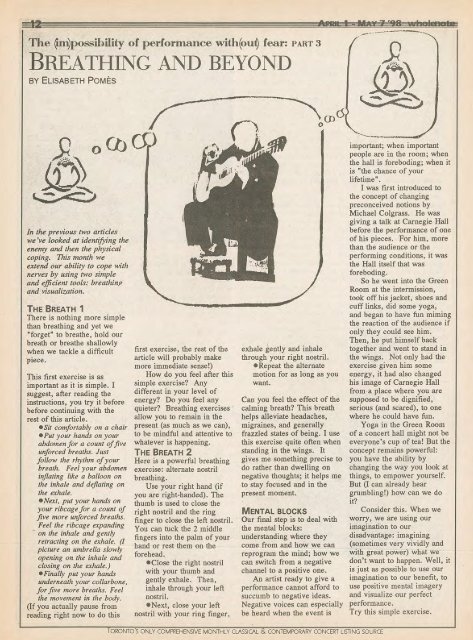Volume 3 Issue 7 - April 1998
Create successful ePaper yourself
Turn your PDF publications into a flip-book with our unique Google optimized e-Paper software.
The ~possibility of performance with(ou~ fear: PART 3<br />
BREATHING AND BEYOND<br />
BY ELISABETH POMES<br />
____ ____ . ..,<br />
In the previous two articles<br />
we've looked at identifying the<br />
enemy and then the physical<br />
coping. This month we<br />
extend our ability to cope with<br />
nerves by using two simple<br />
and efficient tools: breathinp<br />
and visualization.<br />
THE BREATH 1<br />
There is nothing more simple<br />
than breathing and yet we<br />
"forget" to breathe, hold our<br />
breath or breathe shallowly<br />
when we tackle a difficult<br />
·piece.<br />
This first exercise is as<br />
important as it is simple. I<br />
suggest, after reading the<br />
instructions, you try it before<br />
before continuing with the<br />
rest of this article.<br />
•Sit comfortably on a chair<br />
• Put your hands on your<br />
abdomen for a count of five<br />
unforced breaths. Just<br />
follow the rhythm ofyour<br />
breath. Feel your abdomen<br />
inflating like a balloon on<br />
the inhale and deflating on<br />
the exhale.<br />
eNext, put your hands on<br />
your ribcage for a count of<br />
five more unforced breaths.<br />
Feel the ribcage expanding<br />
- on the inhale and gently<br />
retracting on the exhale. (I<br />
picture an umbrella slowly<br />
opening on the inhale and<br />
closing on the exhale.)<br />
• Finally put your hands<br />
underneath your collarbone,<br />
for five more breaths. Feel<br />
the movement in the body.<br />
(If you actually pause from<br />
reading right now to do this<br />
first exercise, the rest of the<br />
article will probably make<br />
more immediate sense!)<br />
How do you feel after this<br />
simple exercise? Any<br />
different in your level of<br />
energy? Do you feel any<br />
quieter? Breathing exercises '<br />
allow you to remain in the<br />
present (as much as we can),<br />
to be mindful and attentive to<br />
whatever is happening.<br />
THE BREATH 2<br />
Here is a powerful breathing<br />
exercise: alternate nostril<br />
breathing.<br />
Use your right hand (if<br />
you are right-handed). The<br />
thumb is used to close the<br />
right nostril and the ring<br />
finger to close the left nostril.<br />
You can tuck the 2 middle<br />
fingers into the palm of your<br />
hand or rest them on the<br />
forehead.<br />
•Close the right nostril<br />
with your thumb and<br />
gently exhale. Then,<br />
inhale through your left<br />
nostril.<br />
• Next, close your left<br />
nostril with your ring finger,<br />
exhale gently and inhale<br />
through your right nostril.<br />
• Repeat the alternate<br />
motion for as long as you<br />
want.<br />
Can you feel the effect of the<br />
calming breath? This breath<br />
helps alleviate headaches,<br />
migraines, and generally<br />
frazzled states of being. I use<br />
this exercise quite often when<br />
standing in the wings. It<br />
gives me something precise to<br />
do rather than dwelling on<br />
negative thoughts; it helps me<br />
to stay focused and in the<br />
present moment.<br />
MENTAL BLOCKS<br />
Our final step is to deal with<br />
the mental blocks:<br />
understanding where they<br />
come from and how we can<br />
reprogram the mind;· how we<br />
can switch from a negative<br />
channel to a positive one.<br />
An artist ready to give a<br />
performance cannot afford to<br />
succumb to negative ideas.<br />
Negative voices can especially<br />
be heard when the event is<br />
important; when important<br />
people are in the room; when<br />
the hall is foreboding; when it<br />
is "the chance of your<br />
lifetime".<br />
I was first introduced to<br />
the concept of changing<br />
preconceived notions by<br />
Michael Colgrass. He was<br />
giving a talk at Carnegie Hall<br />
before the performance of one<br />
of his pieces. For' him, more<br />
than the audience or the<br />
performing conditions, it was<br />
the Hall itself that was<br />
foreboding.<br />
So he went into the Green<br />
Room at the intermission,<br />
took off his jacket, shoes and<br />
cuff links, did some yoga,<br />
and began to have fun miming<br />
the reaction of the audience if<br />
only they could see him.<br />
Then, he put himself back<br />
together and went to stand in<br />
the wings. Not only had the<br />
exercise given him some<br />
energy, it had also changed<br />
his image of Carnegie Hall<br />
from· a. place where you are<br />
supposed to be dignified,<br />
serious (and scared), to one<br />
where he could have fun.<br />
Yoga in the Green Room<br />
of a concert hall might not be<br />
everyone's cup of tea! But the<br />
concept remains powerful:<br />
you bave the ability by<br />
changing the way you look at<br />
things, to empower yourself.<br />
But (I can already hear<br />
grumbling!) how can we do<br />
it?<br />
Consider this. When we<br />
worry, we are using our<br />
imagination to our<br />
disadvantage: imagining<br />
(sometimes very vividly and<br />
with great power) what we<br />
don't want to happen. Well, it<br />
is just as possible to use our<br />
imagination to our benefit, to<br />
use positive mental imagery<br />
and visualize our perfect<br />
performance.<br />
Try this simple exercise.<br />
TORONTO'S ONLY COMPREHENSIVE MONTHLY CLASSICAL & CONTEMPORARY CONCERT USTlNG SOURCE


















